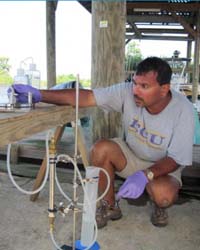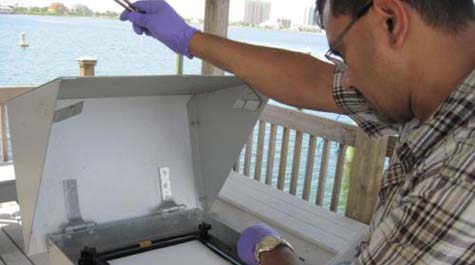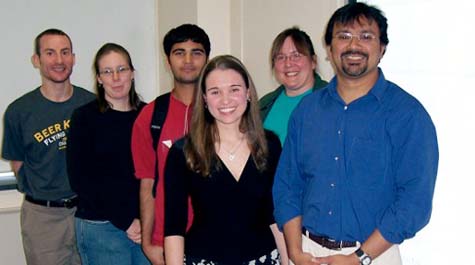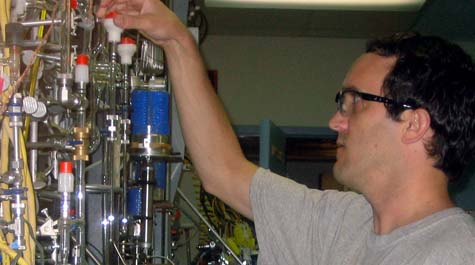Alumnus never lets opportunities pass him by
Mitra praises late VIMS advisor for critical influence on career
Dr. Siddhartha Mitra has achieved
the type of career that many young academics strive for. An accomplished scientist,
professor, and mentor, Mitra credits his strategy of never letting
opportunities pass him by—and the influence of his late academic advisor—for
much of his success.
A 1997 graduate of William & Mary’s School of Marine Science at VIMS, Mitra moved to Gloucester Point in 1991 to pursue his doctorate with Dr. Rebecca Dickhut—a new faculty member who was in the midst of building a program in environmental organic chemistry and seeking motivated students to join her. Now a Professor of Organic Geochemistry at East Carolina University, Mitra says Dickhut’s energy and enthusiasm for her research and students was infectious.
“Rebecca was a tremendous mentor, and approached each of her students differently,” says Mitra. “She would find what motivated each person and what didn’t, which has been one of the most important things she instilled in me as a mentor. You have to find out what makes each person tick, which can be both interesting and challenging.”
While at VIMS, Mitra’s research focused on sediment and pore-water distributions of a group of toxic and cancer-causing chemicals called polycyclic aromatic hydrocarbons (PAHs) in the Elizabeth and Hudson Rivers. Mitra says Dickhut contributed to his research interests, and never pushed him to take on any agenda other than his own. “Rebecca encouraged me to think out my own research topics, which ultimately led to my dissertation interest.”
Mitra’s path to VIMS was paved with many twists and turns. While pursuing his undergraduate degree in mechanical engineering at Lehigh University, Mitra had an epiphany that made him realize an engineering career was not for him. After graduating, he chased his fascination with the natural world to the New Jersey Institute of Technology where he pursued a Master’s degree in Environmental Studies.
At NJIT, Mitra studied toxic metals and how they accumulate in surface waters. After graduating, he accepted a position at the United States Fish and Wildlife Service, where he realized he wanted to gain more first-hand knowledge of estuaries and ecology. “After a couple of years with the USFWS, I realized it was time for me to get my feet wet—literally—and learn about natural systems” he says.
This interest in natural systems brought Mitra to VIMS, where he says he spent some of the best years of his life. “What sold me on VIMS on day one was the fact that you’re allowed to eat and drink in the library,” he laughs. “This was before the internet, so I spent many an hour in that library, reading and sifting through journals, so that was pretty important to me.”
Mitra spent six years at VIMS, researching, discovering, and absorbing as much experience and knowledge as he could. Shortly after earning his Ph.D., what he describes as a “green light” occurred when Dickhut met Dr. Tom Bianchi—a professor at Tulane University—who was seeking a Post-Doctoral Research Associate with PAH experience.
“I’d become very interested in river chemistry and Dr. Bianchi had done some work on the Mississippi River, so it was a no-brainer,” says Mitra. “We each had what the other wanted and needed to make a great team.”
Another “green light” for Mitra occurred as his post-doc was drawing to a close. Mitra was boarding a plane at the New Orleans airport to go to a job interview when he entered into a conversation with the woman in front of him at the Southwest Airlines counter. That woman is now Mitra’s wife. “You have to take advantage of opportunities when life throws them at you. It has worked for me so far,” he says.
At ECU, Mitra’s research focuses on the fate and transport of trace organic chemicals in the environment. As an organic geochemist, one of Mitra’s major areas of research is biogeochemical cycling of black carbon and its effects on the global carbon cycle—a topic he became familiar with during his post-doc at Tulane.
In a paper now in press, Mitra and Dr. Andrew Wozniak—another former Dickhut student—demonstrate the unique composition of marine-derived organic matter in rainwater from Hurricane Irene in 2011. The paper will appear in Marine Chemistry—an international journal for studies of all chemical aspects of the marine environment.
The collaboration between Mitra and Wozniak marks the first research partnership between two of Dickhut’s former students, so it does not come as a surprise that the two scientists dedicated the publication to her.
“Sid and I share an interest in exploring interdisciplinary research using whatever biogeochemical tools that apply, and I attribute this in part to Rebecca’s influence on both of us,” says Wozniack. “Sid’s easygoing, down-to-earth demeanor and enthusiasm for research makes him a fun collaborator, and I suspect many of Rebecca’s collaborators would say the same about her.”
Dr. Rebecca Dickhut joined the VIMS faculty in 1989. During her 22-year career, she became an internationally recognized expert in the field of environmental science, studying the transport and fate of pollutants on a global scale and their implications for ecosystem health, especially in Antarctica and Chesapeake Bay. Dickhut passed away on November 4, 2011.
“A critical lesson Rebecca taught me—which she taught by example—is that a person can be a great scientist and have fun at their job without having a large ego,” says Mitra. “I’ve tried to live by Rebecca’s example throughout my years as a faculty mentor and scientist, which I believe makes for a happier life when all is said and done.”




